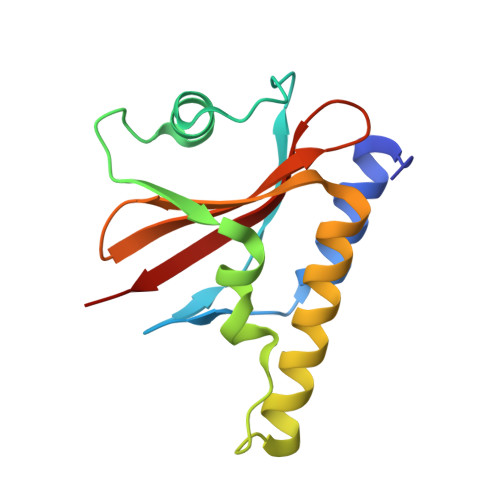The nuclease a-inhibitor complex is characterized by a novel metal ion bridge.
Ghosh, M., Meiss, G., Pingoud, A.M., London, R.E., Pedersen, L.C.(2007) J Biol Chem 282: 5682-5690
- PubMed: 17138564
- DOI: https://doi.org/10.1074/jbc.M605986200
- Primary Citation of Related Structures:
2O3B - PubMed Abstract:
Nonspecific, extracellular nucleases have received enhanced attention recently as a consequence of the critical role that these enzymes can play in infectivity by overcoming the host neutrophil defense system. The activity of the cyanobacterial nuclease NucA, a member of the betabetaalpha Me superfamily, is controlled by the specific nuclease inhibitor, NuiA. Here we report the 2.3-A resolution crystal structure of the NucA-NuiA complex, showing that NucA inhibition by NuiA involves an unusual divalent metal ion bridge that connects the nuclease with its inhibitor. The C-terminal Thr-135(NuiA) hydroxyl oxygen is directly coordinated with the catalytic Mg(2+) of the nuclease active site, and Glu-24(NuiA) also extends into the active site, mimicking the charge of a scissile phosphate. NuiA residues Asp-75 and Trp-76 form a second interaction site, contributing to the strength and specificity of the interaction. The crystallographically defined interface is shown to be consistent with results of studies using site-directed NuiA mutants. This mode of inhibition differs dramatically from the exosite mechanism of inhibition seen with the DNase colicins E7/E9 and from other nuclease-inhibitor complexes that have been studied. The structure of this complex provides valuable insights for the development of inhibitors for related nonspecific nucleases that share the DRGH active site motif such as the Streptococcus pneumoniae nuclease EndA, which mediates infectivity of this pathogen, and mitochondrial EndoG, which is involved in recombination and apoptosis.
Organizational Affiliation:
Laboratory of Structural Biology, NIEHS, National Institutes of Health, Research Triangle Park, North Carolina 27709, USA.


















